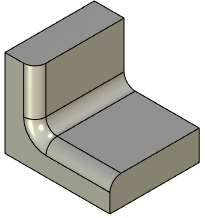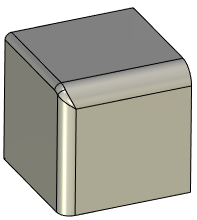Edge Processing Order when Blending Vertices |
  
|
A single operation can be used for blending all edges meeting at one vertex. The edges can be of either the convex or the concave type. Simultaneous blending of all edges meeting at one vertex automatically involves blending of vertex itself.


A shape of blending geometry at a vertex can be changed by choosing a different Edge Processing Order: Default (the order of smoothing edges is determined by the system independently), Concave blends first, Convex blends first, On edges of minority convexity first, On edges of majority convexity first. Please note: in order to control a shape of blending at a vertex, it is necessary to select this vertex in addition to the edges when creating blending.
This option is not available for chamfers.
|
|
Red edge - convex, Green edges - concave, Green square - blended vertex |
|
|
|
Convex blends first |
Concave blends first |
To avoid the vertex blending, do the edge blending by two blending operations, first blending any two edges meeting at a vertex, and then the third edge, by disabling the Propagate option. The result in this case will look as shown here:
|
|
First blend |
Second blend |
Sometimes it is impossible to blend all edges at once, and the system outputs an error. In this case, try creating the intended blends by steps.
The above implies that proper handling of the operation leads to successful blending of practically any edges of any model.
It is recommended to use as few operations as possible when blending several edges of one solid. Prefer blending a set of edges by one operation, rather than by a number of operations one edge at a time. With this approach, the model regeneration is much faster, and the blending algorithm most likely performs best.